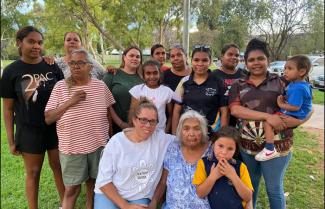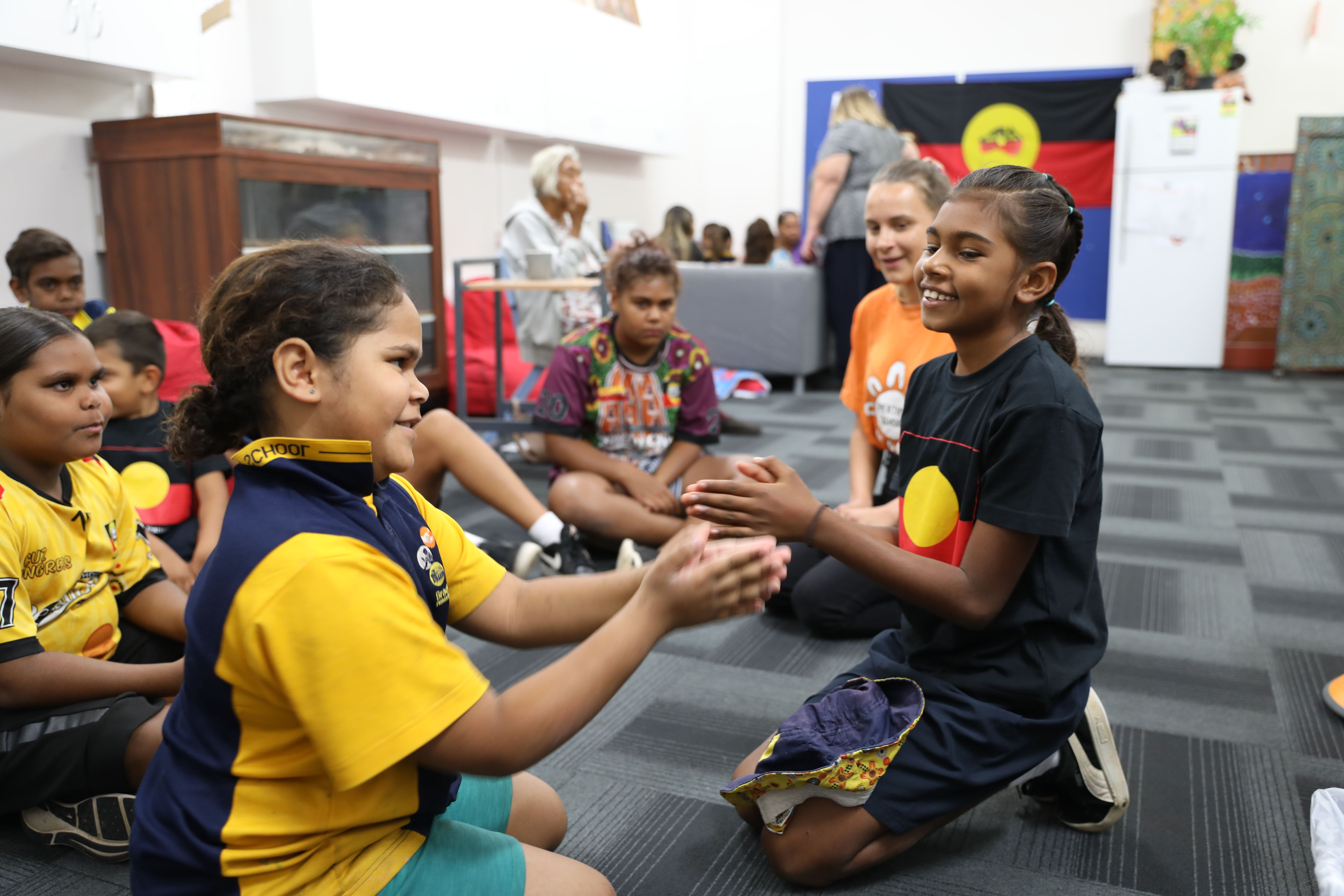
Pertame, or southern Arrernte, is an Indigenous Australian language that belongs to the country south of Alice Springs in central Australia. Pertame is a severely endangered language with only 10-20 Elders still with us who are fluent speakers. The grandparent and great grandparent generation of Pertame people grew up on their homelands speaking Pertame as their first language every day with their extended family together as one. Due to central Australia’s colonial history, Pertame is no longer the language spoken in the homes of most Pertame families or taught to the children as their first language. Without serious action, Pertame will be lost within the next generation. Our Pertame Language Revival Program aims to breathe life into our language again by growing the next generation of Pertame fluent speakers to create a culturally strong, connected, and thriving Pertame community. Our entire language program is run by strong Pertame women because we are the people who are raising the children, who are the future of our language.
Our Pertame matriarch, Christobel Swan, is the backbone of our program. She has memories of receiving physical punishment at school for speaking Pertame, yet she never forgot her language. I would always hear her say, “why should I speak English? That’s not my language.” She was in the first group of Aboriginal interpreters in Australia, working for 30 years within the courts and hospitals and with the police to translate for Aboriginal people. She also co-created the first Pertame wordlist in the 1990s, when the linguistic world did not acknowledge Pertame as its own language. Today, at age 75, Swan is with us every day, gifting us our language. She was just awarded the prestigious honor of National Aboriginal and Islanders Day Observance Committee Female Elder of the Year for 2021.
My passion for language grew with my connection to Nana Chrissy. I grew up in Canberra and moved to Alice Springs when I was 20 years old. I would volunteer every week, joining my nana and a linguist as they worked to record the Pertame language. I was so thirsty to hear and learn my heritage language, which I never had exposure to growing up. Eventually I took on more responsibility over the language program, working with my auntie to run a few community language camps on our homeland. But I knew that four weekend-long camps a year were not enough to save our language. I knew something was missing.
In 2019, My nana and I were invited by Halay Turning-Heart (Seminole and Yuchi), shUshpa Richard Grounds, and the Global Indigenous Language Caucus to the United Nations Permanent Forum on Indigenous Issues in New York, where I attended their training on Master-Apprentice Programs. The Master-Apprentice Program (MAP) is a world-leading method of Indigenous language revival that was developed by Indigenous communities in California. The MAP model grows new fluent speakers through intensive oral immersion sessions with Elder speakers (the master) and adult learners (apprentices). Elders and apprentices are to spend 10–20 hours together each week, talking only in their Indigenous language, to recreate the natural intergenerational transmission that infants receive when acquiring their first language from their home environments.
I took the knowledge I gained in New York back to our Pertame community, who were excited to try the program. My community instantly resonated with the program methodology so aligned with Pertame worldviews of knowing and teaching, and that valued Elder wisdom and breath-to-breath intergenerational knowledge transfer above all else.
Our MAP team is made up of our Elder master, Nana Christobel Swan, and my two aunties, Auriel Swan and Leeanne Swan, my cousin, Samantha Armstrong, my niece, Shania Armstrong, and myself as the apprentices. As apprentices, every bit of Pertame we learn, we share with the younger generations. We run holiday programs and classes for Pertame children at two primary schools in Alice Springs and take the language back home to share it with the children in our households. The kids love seeing their family come into their school so they can learn their own language and culture.

Children playing handclapping games in Pertame as part of the Pertame Primary School program. Photo by Emmanuelle Clarke.
Bringing Pertame Home
Eventually we noticed it was not enough to teach the children at school, only for them to go home to be surrounded by the colonial language again. We needed to bring Pertame home, where it belonged. We started a casual adult evening class in my auntie’s backyard to focus on teaching the mothers and nanas of our students a few key phrases that they could say every day in the household to their children. We started with phrases like, “Where are your shoes?” “Get up for school,” and “Go to bed.” The adult generation are mainly silent speakers, understanding Pertame but unable to reproduce it, so they are very familiar with all the phrases. I see a major healing process with the women as they finally give each other and themselves permission to put the language on their tongues, perfect or not. An important lesson I learnt in New York is that “the only way to speak your language wrong is to not speak it at all.”
In Australia, our biggest challenge is securing enough funding required to do this work. The only government funding specifically for Indigenous languages that we can access are the Indigenous Languages and Arts Program grants. One of the program’s goals is to support the intergenerational transmission of Indigenous languages, but the criteria for what they fund is about producing a resource, something that they can hold in their hands and say, “look at what we did for your languages.” We have so much trouble trying to get the government to fund a project that focuses on creating a new fluent speaker, which is a much longer, more resource intensive process.
No one in Australia is talking about the creation of new fluent speakers, or what it actually means to reintroduce our languages as the spoken word of our communities and cultures. We are almost satisfied with giving our children some language knowledge and letting our Elders’ language fluency live in recordings and archives. There are 78 Australian languages in the same position as Pertame, with few fluent speakers all within the oldest generation. We cannot let our language bearers’ last precious moments with us be used up working with community outsiders, creating a dictionary. We have to think critically about how we can revive our intergenerational transmission before more of our languages fall asleep, and the answer is within our culture. Our languages were oral, passed down through the generations for more than 60,000 years. An app is not going to save us; our Elders will. The Australian government needs to recognize the crisis on their hands with the disappearance of our remaining languages and redirect resources towards language immersion and the concentrated effort of fluent speaker creation through breath-to-breath intergenerational language teaching.
Every day I am blessed with the honor to sit down with my nana, my two aunties, cousin, and niece to hear my language in its full form. I learn my language through joy, jokes, laughter, gossip, frustration, fights, family, and mostly love. There is no place that our languages make more sense than in our community. Stale words on a page or an audio clip do not come close to the way I experience my language, and I want every Indigenous young person who still has their fluent speakers with them to experience this gift.
I know that every moment we have in our Master-Apprentice sessions is fleeting. Our Elders will not be here forever, so I cherish every precious second. Whenever another Pertame Elder passes away, I feel a great loss. Many times I have been at funerals, mourning their loss and worrying for the future of our language. But then I hear that their great-great-greatgrandchild has just been born, and I know that we never really lose without gaining, and that our culture has a strong past and an equally strong future.
Nwerna Pertama Relha Mapa
Nwerna nhanhala kweta nema
Nwernaka ngetya itya yerrema
We are Pertame people
We have always been here
Our language will never die
In every Pertame class we get the children to recite this chant in Pertame. When I ask them, “why will our language never die?”, they tell me, “because we are still speaking it.”
Kela marra
— Vanessa Ngala Farrelly (Pertame Southern Arrernte) is currently employed by the Batchelor Institute of Indigenous Tertiary Education as the Pertame Research Officer within the Centre for Australian Languages and Linguistics (CALL). She is also a Master’s research student within the Batchelor Institute Post-Graduate program and coordinates the Pertame Language Revival Program, the only active Master-Apprentice Program (MAP) in Australia. In only 16 months, the Pertame MAP produced four semi-fluent speakers, ran 107 Pertame MAP immersion sessions totaling over 400 hours, and 5 on-country immersion camps. A total of 7 Pertame apprentices, 5 elders, 60 children, and 40 adults have been engaged in teaching and learning the Pertame language.
Top photo: Pertame family members during an Adult Language Class in Alice Springs. L-R: Brittany Swan, Sharlene Swan, Leeanne Swan, Kayla Dashwood, Michelle Swan, Abby-lee Dodd, Justyse Nandy, Auriel Swan, Shania Armstrong, Christobel Swan, Sumaiya Nandy, Samantha Armstrong, Diandra Armstrong, and Max King. Photo by Vanessa Farrelly
